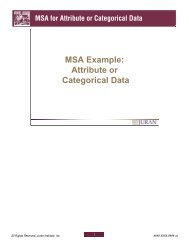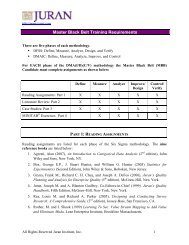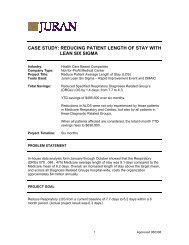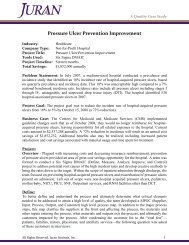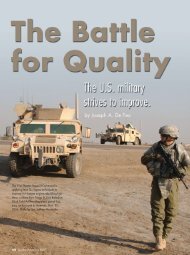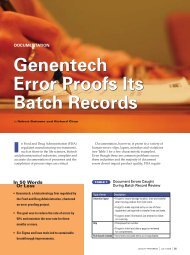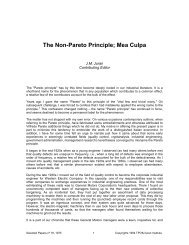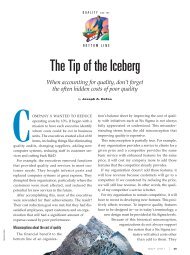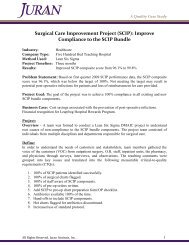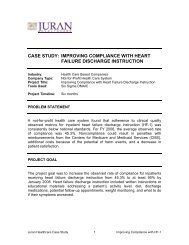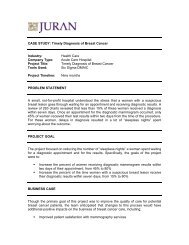Ch2 JAD Breakthrough and Beyond.pdf - Juran Institute
Ch2 JAD Breakthrough and Beyond.pdf - Juran Institute
Ch2 JAD Breakthrough and Beyond.pdf - Juran Institute
You also want an ePaper? Increase the reach of your titles
YUMPU automatically turns print PDFs into web optimized ePapers that Google loves.
32 CHAPTER Two<br />
THE BASIC TASK OF MANAGEMENT: THE JURAN TRILOGY 33<br />
forces have no skill in, or responsibility for, product or process<br />
design or redesign.) As time passes, the chronic level of waste<br />
becomes regarded as the norm. ("That's how it is in this business.")<br />
Some think of it as a fate that is not susceptible to<br />
improvement. With the passage of more time, almost by<br />
default, the "norm" eventually becomes designated as the<br />
"st<strong>and</strong>ard," <strong>and</strong> the associated costs of poor quality are<br />
unknowingly built into the budget! In our example, unless the<br />
COp3 does not in effect exceed 22 percent, performance is not<br />
regarded as abnormal or bad, or exceeding the budget! The<br />
organization has thus desensitized itself from recognizing its<br />
major opportunities for bottom-line-boosting improvements.<br />
(Dr. <strong>Juran</strong> would say that the management alarm system has<br />
been disconnected.) Furthermore, the cost accounting system<br />
usually does not provide managers with complete information<br />
about the levels of COp3. So it is not surprising that defects are<br />
not addressed <strong>and</strong> corrected.<br />
CONTROL<br />
To return to Figure 2.3, when the COp3 sporadically flares up<br />
to unusually high levels in some locations, this triggers troubleshooting<br />
or quality control. Control consists of measuring<br />
actual performance, comparing actual to the st<strong>and</strong>ard, <strong>and</strong> taking<br />
action on the (bad) difference.<br />
Control employs the feedback loop, which results in corrective<br />
action. The elements of the feedback loop (<strong>and</strong> hence of<br />
control) are (I) the control subject, which is the process or product<br />
characteristic to be controlled; (2) a sensor, which measures<br />
the control subject; <strong>and</strong> (3) an umpire who receives the measure<br />
from the sensor, <strong>and</strong> then consults (4) the st<strong>and</strong>ard (expressed in<br />
units of measure). If the st<strong>and</strong>ard is not met, the umpire energizes<br />
(5) an actuator, who adjusts the process to bring it back<br />
into compliance with the st<strong>and</strong>ard. The actuator may be a<br />
device, a supervisor, or persons doing the work being controlled.<br />
Example of Control<br />
The thermostat. The thermostat is an example of an automated<br />
feedback loop, where all the elements of the feedback<br />
Measure<br />
Actual<br />
Performance<br />
FIGURE 2.4<br />
OK<br />
Control feedback loop.<br />
Regulate<br />
Process<br />
Not OK<br />
Established<br />
St<strong>and</strong>ards<br />
loop, except establishing the st<strong>and</strong>ard, are performed automatically<br />
by means of a device or devices. (1) The control subject<br />
is ambient air -temperature. (2) The sensor is a thermometer<br />
that measures temperature. (3) The st<strong>and</strong>ard is whatever temperature<br />
at which the thermostat is set. (4) The umpire consists<br />
of mechanical contacts. As temperature increases beyond<br />
the temperature setting, contact is made, which energizes the<br />
(5) actuator (a circuit breaker) <strong>and</strong> the heat is shut off. When<br />
temperature falls below the temperature setting, the contact<br />
causes the heat to be turned back on.<br />
Control is a form of improvement, in the sense that a bad situation-failing<br />
to meet the st<strong>and</strong>ard-is made better by re-attaining<br />
the current st<strong>and</strong>ard, but it is not breakthrough improvement.<br />
It is merely removing unwanted change <strong>and</strong> restoring the process<br />
to meet the current st<strong>and</strong>ard. (A discussion of control is contained<br />
in Chapter 4, "The Control Processes.") Control is carried<br />
out by a more or less st<strong>and</strong>ard sequence of events:<br />
• Evaluate actual performance.<br />
• Compare actual performance with the st<strong>and</strong>ards.<br />
• Act on the (bad) difference.<br />
Attaining a better new st<strong>and</strong>ard of performance requires<br />
breakthrough in the chronic level of performance.



